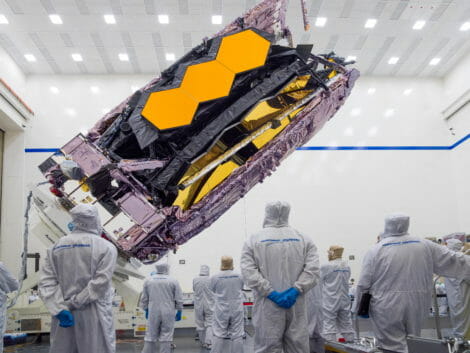NASA’s new space telescope reaches destination in solar orbit

FILE PHOTO: The James Webb Space Telescope is packed up for shipment to its launch site in Kourou, French Guiana in an undated photograph at Northrop Grumman’s Space Park in Redondo Beach, California. NASA/Chris Gunn/Handout via REUTERS
NASA’s James Webb Space Telescope, designed to give the world an unprecedented glimpse of infant galaxies in the early stages of the universe, arrived at its gravitational parking spot in orbit around the sun on Monday, nearly a million miles from Earth.
With a final five-minute, course-correcting thrust of its onboard rocket, Webb reached its destination at a position of gravitational equilibrium known as the second Sun-Earth Lagrange point, or L2, arriving one month after launch, NASA officials said.
The thruster was activated by mission control engineers at the Space Telescope Science Institute in Baltimore, with radio signals confirming Webb was successfully “inserted” into its desired orbital loop around L2.
From there, Webb will follow a special “halo” path that keeps it in constant alignment with Earth but out of its shadow, as the planet and telescope circle the sun in tandem. The prescribed L2 orbit within the larger solar orbit thus enables uninterrupted radio contact, while bathing Webb’s solar-power array in non-stop sunlight.
By comparison, Webb’s 30-year-old predecessor, the Hubble Space Telescope, orbits the Earth from 340 miles (547 km) away, passing in and out of the planet’s shadow every 90 minutes.
The combined pull of the sun and Earth at L2 – a point of near gravitational stability first deduced by 18-century mathematician Joseph-Louis Legrange – will minimize the telescope’s drift in space.
But ground teams will need to fire Webb’s thruster briefly again about once every three weeks to keep it on track, Keith Parrish, the observatory’s commissioning manager from NASA’s Goddard Space Flight Center in Maryland, told reporters on Monday.
Mission engineers are preparing next to fine-tune the telescope’s primary mirror – an array of 18 hexagonal segments of gold-coated beryllium metal measuring 21 feet, 4 inches (6.5 meters) across, far larger than Hubble’s main mirror.
Its size and design – operating mainly in the infrared spectrum – will allow Webb to peer through clouds of gas and dust and observe objects at greater distances, thus farther back in time, than Hubble or any other telescope.
These features are expected to usher in a revolution in astronomy, giving a first view of infant galaxies dating to just 100 million years after the Big Bang, the theoretical flashpoint that set the expansion of the known universe in motion an estimated 13.8 billion years ago.
Webb’s instruments also make it ideal to search for signs of potentially life-supporting atmospheres around scores of newly documented exoplanets – celestial bodies orbiting distant stars – and to observe worlds much closer to home, such as Mars and Saturn’s icy moon Titan.
Next steps
It will take several more months of work to ready the telescope for its astronomical debut.
The 18 segments of its principal mirror, which had been folded together to fit inside the cargo bay of the rocket that carried the telescope to space, were unfurled with the rest of its structural components during a two-week period following Webb’s launch on December 25.
Those segments were recently detached from fasteners and edged away from their original launch position. They now must be precisely aligned – to within one-ten-thousandth the thickness of a human hair – to form a single, unbroken light-collecting surface.
Ground teams will also start activating Webb’s various imaging and spectrographic instruments to be used in the three-month mirror alignment. This will be followed by two months spent calibrating the instruments themselves.
Mirror alignment will begin by aiming the telescope at a rather ordinary, isolated star, dubbed HD-84406, located in the Ursa Major, or “Big Dipper,” constellation but too faint to be seen from Earth with the naked eye.
Engineers will then gradually tune Webb’s mirror segments to “stack” 18 separate reflections of the star into a single, focused image, Lee Feinberg, Webb’s optical telescope element manager at Goddard, said during Monday’s NASA teleconference.
Alignment is expected to start next week when the telescope, whose infrared design makes it super-sensitive to heat, has cooled down enough in space to work properly – a temperature of about 400 degrees below zero Fahrenheit (-240 Celsius).
If all goes smoothly, Webb should be ready to begin making scientific observations by summer.
Sometime in June, NASA expects to make public its “early release observations,” a “greatest hits” collection of initial images used to demonstrate the proper functioning of Webb’s instruments during its commissioning phase.
Webb’s most ambitious work, including plans to train its mirror on objects farthest from Earth, will take a bit longer to conduct.
The telescope is an international collaboration led by NASA in partnership with the European and Canadian space agencies. Northrop Grumman Corp was the primary contractor.
RELATED STORIES
‘Amazing milestone’ as Nasa fully deploys Webb telescope in space
NASA’s next big space telescope set for blastoff from French Guiana